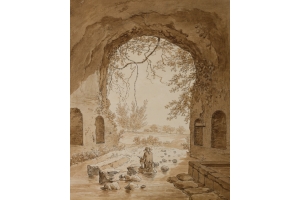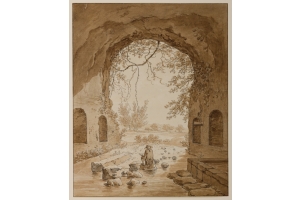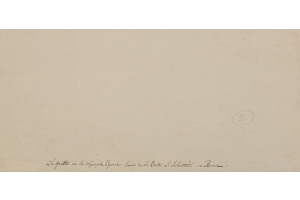


Daniël Dupré was raised by well to do parents. His first apprenticeship was to the landscapist Johannes van Dregt (1737-1807), after which Daniël joined the Amsterdam Drawing Academy (Amsterdamsche Stads Teeken Akademie) where he was taught by Jurriaan Andriessen (1742-1819). He made study travels to Swiss and Germany and in 1783 along the river Rijn, accompanied by his friends Jan Ekels de Jonge (1759-1793) and Jacques Kuyper (1761-1808).[1][2]
In 1786 he delivered a painting for which he was awarded a sum of money by "den Oeconomischen Tak van de Hollandsche Maatschappij der Wetenschappen te Haarlem" (Oeconomical department of the Dutch Society of Sciences Haarlem) for a travel to Germany and Rome to accomplish his skills as a landscapist and draughtsman, from which he returned in 1790. Besides Rome, he visited Sorrento, Capri, Pozzuolo, Naples, Tivoli, Civita Castellana and many more places.[3]
He sent his annual attributions to the above mentioned department as well as drawings which he sent to Amsterdam to be sold by his friends Dirk Versteegh (who was born on the same day as Dupré) and Jan Tersteeg to collectors. After a period of five years he returned to Amsterdam where he spent the rest of his life as a landscapist. Most of his drawings have annotations in French on the verso, describing the locations depicted. Dupré is known to have sold many drawings by his friend Jean Grandjean, who sent his sheets from Rome to Dupré in Amsterdam. The latter who finished several of these sheets with staffage. As the present drawing is not dated, it remains unknown whether Dupré made this during his visit to Rome or afterwards, after 1791 on his return to Amsterdam.[4][5]
On the Grotto of Nymph Egeria;
The grove and spring, dedicated to Egeria, is located close to the Porta Capena, the gate of Rome and was to be used exclusively by the Vestals (priestesses of Vesta). The nymph Egeria was a Roman goddess and advisaor to Numa Pompilius, the second Sabine King of Rome.
The Grotto of Nymph Egeria has been drawn and painted by numerous draughtsmen and landscapist prior to Dupré (Breenbergh, Withoos, Toeput etc), although Dupré has drawn himself in the centre of the Grotto while sketching, which makes the present drawing an important piece within his (drawn) oeuvre.[6]
Dupré also painted a version of the Grotto of Nymph Egeria, which he exhibited in Amsterdam, 1810.[7]
The composition of our drawing, which has been drawn with Dupré's most frequently used media of pen and black ink and brown wash, closely resembles that of the drawing present in the coll. Rijksmuseum, Amsterdam, previously in the coll. of Prof. I.Q. van Regteren Altena.[8]
He was awarded with a second price in 1803 at society Felix Meritis Amsterdam for an arcadian lanscape. He exhibited frequently in Amsterdam during the following years between 1808-1814. Dupré was member of several distinguished drawing academies outside The Netherlands and was appraised for his skillful topographical qualities as a draughtsman. Johannes Ernst Marcus engraved his portrait for "Studie Beelden en Fragmenten". Shortly after his death Dupré’s estate was sold at auction.[9]
[1] Roeland van Eijnden, Adriaan van der Willigen, Geschiedenis der Vaderlandsche Schilderkunst. A. Loosjes Pz., Haarlem, 1806. P. 393-397 (Vol. II) and 187 (Vol IV).
[2] J.W. Niemeijer, Hollandse aquarellen uit de 18e eeuw. Waanders, Zwolle, 1990. p. 50-55.
[3] Ingrid Oud, Michiel Jonker, Marijn Schapelhouman, In de ban van Italië; tekeningen uit een Amsterdamse verzameling. Architecture & Natura, Amsterdam, 1995. p. 67-74. Cat. no. 43-49.
[4] Ontmoetingen met Italië : tekenaars uit Scandinavië, Duitsland, Nederland in Italië 1770-1840. Rijksmuseum, Amsterdam, 1971. p. 14-15.
[5] Charles Dumas, Robert-Jan te Rijdt, Kleur en raffinement; Tekeningen uit de Unicorno collectie. Waanders, Zwolle, 1994. p. 127-128.
[6] I.Q. van Regteren Altena, Vereeuwigde stad : Rome door Nederlanders getekend, 1500-1900. Nederlands Kunstbezit uit openbare verzamelingen, Amsterdam, 1964. p. 100-101, cat. no. 27-29.
[7] Daniël Dupré, De Grot van de Nymph Egeria buiten Rome. Cat. no. 38. Lyst der kunstwerken van nog in leven zynde Hollandsche meesters, welke tot de algemeene tentoonstelling van 1810 zyn toegelaten. Amsterdam, 1810. No. 38
[8] Daniël Dupré, Een gids in een grafmonument dicht bij Pozzuoli. Pencil, pen and brush and brown ink, brown wash, 163 x 156 mm. Rijksmuseum, Amsterdam, inv. No. RP-T-2014-13-29. From the former collection of Prof. I.Q. van Regteren Altena.
[9] Een fraaije verzameling schilderijen, teekeningen, prenten en prentwerken in lijsten en glazen ... nagelaten door wijlen de heeren Philippus van der Schley, makelaar in kunstwerken alhier, en Daniel du Pré, kunstschilder lid van het Koninklijk Nederlandsch Instituut. 22 December 1817, Huize Roos, het Huis met de Hoofden, Keizersgracht, tussen de Heerenstraat en de Leliegracht, Amsterdam.